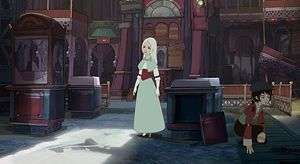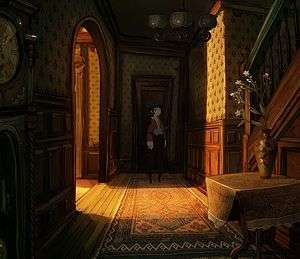The Devil’s Men – Preview
by Edward

|
 As the industry marches forward, it becomes harder and harder to find genuine innovations in your favourite genres. That’s not to say that there’s a lack of imagination – although the prevalence of first-person shooters and zombies would definitely indicate otherwise – but it’s often the case that it just doesn’t seem possible to bring something truly unique to the table. Sometimes, it’s not a case of bringing something new, but learning from the advancements of others and converting it into something incredible.
As the industry marches forward, it becomes harder and harder to find genuine innovations in your favourite genres. That’s not to say that there’s a lack of imagination – although the prevalence of first-person shooters and zombies would definitely indicate otherwise – but it’s often the case that it just doesn’t seem possible to bring something truly unique to the table. Sometimes, it’s not a case of bringing something new, but learning from the advancements of others and converting it into something incredible.
Meet Daedalic’s The Devil’s Men. Created and written by Kevin Mentz, the man behind last year’s Memoria, and taking the form of a Steampunk crime-solving adventure game, the premise alone is more than enough to intrigue. The story takes place in a fictional coastal town back in the Victorian era and twenty years after the Great World Exhibition. In this universe, the town held host to some of the festival, but has suffered for it ever since, falling into a disparate poverty and creating a massive gap between the haves and have-nots. Further emphasising this stark contrast are our two heroines Emily and Adelaide; one is the right-hand lady of the town’s resident crime lord and currently wanted for double murder, while the other is a peg-legged daughter of Karol Spektor, a Sherlock Holmes-esque character who has been missing for quite some time.
The mystery begins, as often they do, with a series of brutal murders. Rather than it being a spate of random killings, the victims all have something unique in common – they were all members of The Devil’s Men, a society of scientists who’ve named themselves after fictional characters guilty of selling their soul to Satan. As their name might imply the society is populated by some pretty bad guys, which gives rise to an important question – is the murderer actually a force for good, or a portent of darker things to come? The only thing we know for sure is that one of the murders had a witness in the form of Adelaide, who becomes intent on bringing the culprit down; not just because she wants to put a stop to the killings, but because putting together all the clues and solving the case might lead to her finally unveil the fate of her father, whose best friend she’s just seen killed.
During her quest Adelaide teams up with Emily, and this is where The Devil’s Men truly comes into its own and becomes something incredible. While Telltale’s flagship series have eschewed the traditional point-and-click structure in the name of a linear narrative experience, Mentz has instead taken that core morality mechanic and applied it to the conventional adventure game style that Daedalic are best known for. Instead of travelling through a story and picking different moral choices through dialogue, your decisions are made in the way you solve the puzzles.
What this means for the player is that there’s often more than one way to solve the problem at hand, but you’ll constantly have to think about the potential consequences of how you actually do it. There’ll constantly be situations where a solution could make one character’s life easier but another’s far more difficult, and how the player chooses to handle this particular balancing act will affect the way that the story and future puzzles will play out. Even the most innocuous puzzle could have massive ramifications due to the way the player chooses to handle it, meaning that you’re unlikely to get the same experience in multiple playthroughs.
 With this in mind, Kevin showed us a scene in the game twice over with different decisions made each time to aptly demonstrate the differences at play. In both cases, Emily was snooping around a house that Adelaide also happened to be investigating at the behest of a detective’s wife. In the first run-through, Emily came across a door that lead to a cellar under the stairs and chose to bypass the lock in order to see what lay beyond. Even here, Emily had two choices; either pick the door with a lockpick, a time-consuming process that could see her get caught, or use a crowbar instead, which would open the door far quicker but leave traces behind that could potentially be tied back to her. Further complicating matters is the fact that both things are limited consumable items, so using them all up early on could make life more difficult later.
With this in mind, Kevin showed us a scene in the game twice over with different decisions made each time to aptly demonstrate the differences at play. In both cases, Emily was snooping around a house that Adelaide also happened to be investigating at the behest of a detective’s wife. In the first run-through, Emily came across a door that lead to a cellar under the stairs and chose to bypass the lock in order to see what lay beyond. Even here, Emily had two choices; either pick the door with a lockpick, a time-consuming process that could see her get caught, or use a crowbar instead, which would open the door far quicker but leave traces behind that could potentially be tied back to her. Further complicating matters is the fact that both things are limited consumable items, so using them all up early on could make life more difficult later.
Opting to use a crowbar for this particular door, Emily could then attempt to crack the safe hidden behind it using the clues scattered about the house, and come across something that could turn out to be vital later on. However, if the player opted to take an alternative path through this scene, then it’s likely they’d never open the door and discover this important clue. In this case the action cuts to Adelaide – who was previously sleeping in a nearby room – who discusses information with the home-owner that Emily overhears and discovers would be beneficial to her gang, should she choose to tell them. Unfortunately, Emily is unable to sneak out unseen, as Adelaide notices the door’s been forced open and finds her, forcing her to hide her delinquent friend in another room to avoid her being caught.
In a second playthrough Emily stumbles across Adelaide sleeping in one of the rooms and elects to wake her up, causing Adelaide to panic over the presence of her friend and drag her to the same room as before, but now the entire context is different. When Emily asks Adelaide what’s going on, there’s more weight riding on whether she reveals pertinent information. There’s no longer an opportunity to break into the safe and potentially get caught, but there’s still a chance to get Adelaide to spill the beans and provide information that Emily could use to her advantage. It’s the same core location, but the actions and consequences are wholly different to the point of producing entirely different gameplay states; in the former, Emily has the upper-hand and can make her life far easier, but in the latter Adelaide holds all of the cards.
This ability to constantly shift the balance of narrative and power between the leads isn’t the only reason that The Devil’s Men intrigues. For one, there’s the hauntingly beautiful setting of a Victorian town with a Steampunk aesthetic that’s long-fallen into disrepair and neglect. A simple town that hoped hosting part of the Great World Exhibition would see them prosper, only to have it throw them into ruin is a particularly soul-stirring and evocative idea. Then there’s the art-style that pits two-dimensional characters against three-dimensional environments and a dynamic camera in a manner that bears more than a few passing resemblances to the fantastic Curse of Monkey Island, yet feels completely distinct.
Then there’s the way that the inventory system has been overhauled, meaning that you can no longer just pick up everything that isn’t bolted down in the vain hopes it’ll come in useful later. Instead, each character carries a sack about with them, and your inventory is literally confined to what you can keep inside it, so you’re limited to what either character could realistically carry. Players can keep track of what they’re doing through what’s being dubbed the ‘clue inventory’, which acts as a mix between your quest-log and all of the available clues you have at hand. A unique feature of this system allows you to combine any of the clues you have in this inventory, and if they fit together, then you can discover new leads and lines of investigation. Throw in a day and night mechanic where scenes that take place in view of the moon can have an effect on events that occur during the day, and it’s clear that there’s far more going on than you’d originally think of a title in this genre.

If The Devil's Men were made by Lucas Arts in the 1990s. Yeah, we're obviously REALLY short of images.
If anything, that’s one of the most appealing things about The Devil’s Men. Despite its framing as a traditional point-and-click, there’s plenty of evolution and innovation at hand that proves it’s anything but. Where developers like Telltale couldn’t find a way to pair moral ambiguity with puzzle-solving, Kevin Mentz and Daedalic have managed to do so without altering the genre entirely, and are offering something far more appealing as a result. Here, we have a story involving multiple protagonists where many of the puzzles come with more than one solution, and the events and consequences that play out are dependent not on what moral choices you make through dialogues, but through the way you solve the puzzles. That alone is utterly amazing, and will almost certainly be enough to make sure you want to play it through again and again. And again.
Combining a beautiful setting with a distinctive art-style, along with an involving story that evolves not through how you talk but how you play, The Devil’s Men is going to be something incredible.
Last five articles by Edward
- Best of 2015: Journey's End: A New Beginning
- Journey's End: A New Beginning
- You Can't Choose Your Happy Ending
- Okay, Let's Fix Comedy In Games - The V-Effekt
- Time Keeps On Smashing Away






















There are no comments, yet.
Why don’t you be the first? Come on, you know you want to!